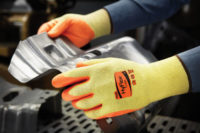One of the things I encourage safety professionals and buyers to understand is the concept of “threshold.†That’s the minimum requirements gloves must possess to be worn — willingly. We all know that workers will wear gloves when being observed by the site safety manager, during an inspection or when they believe they are at risk of being “caught†without the required protection. But what makes workers want to wear gloves, all the time, without pressure from management?
Meeting the threshold
Part of the answer is that the gloves must be manufactured to exceed a threshold comprised of comfort and precision. If gloves supplied to workers don’t exceed this threshold, they will not be worn and injuries will occur, as is indicated by the fact that most hand injuries occur while gloves are not in use.The first component, comfort, is a combination of criteria such as fit, texture, feel, breathability, wicking away moisture and even the look of the glove. Not only must the glove provide physical comfort, but the worker must be comfortable wearing it — including the way it looks — so color and design count, too. If you question this belief, just take a look at the styles in protective eyewear and clothing.
The second component, precision, is determined by criteria such as tactile sensitivity and dexterity. Precision determines how well workers can perform tasks with the glove on. One sure way to increase the risk of hand injuries is to give a worker a task, a productivity objective and a pair of gloves that will make performing the task next to impossible. The gloves will come off, the productivity objective will be met, and only luck will prevent the injury. Luck, by the way, is not an OSHA-accepted PPE item.
Reaching a compromise
So what about protection? Unfortunately, many workers put this third on the list, while safety professionals and buyers place it first. How can manufacturers help reconcile these seemingly “irreconcilable differences?†The answer lies in innovation, education, and in some cases, compromise. Let’s look at the latter component in this reconciliation process first.One customer was using a 7-gauge, cut-resistant glove in their meat-cutting department. After analyzing their hand injuries, they determined the vast majority occurred when gloves were not worn even though they were provided and required.
Sound familiar?
It should, it’s a trend across every industry. So what did this customer do? They changed to a lower rated glove that was more comfortable. Employees wore them; many injuries were eliminated while the remainder were less severe. They considered the change an overwhelming success. Compromise — the job of management and the buyer. Although this concept may well fly in the face of conventional wisdom, the results speak clearly.
Education, too, is a responsibility of management and the glove buyer. Most important is letting workers experience the wide range of available glove styles. Different workers will find different gloves meet or exceed the threshold; what works for one may not work for another. It is counterproductive to safety goals to assume a “one-style-fits-all†approach to glove specification. Let your workers choose; the benefit of having the gloves worn will greatly outweigh the complexity required to stock more than a few styles.
Changing the threshold
Innovation is the responsibility of the manufacturer. Our job is to increase protection while staying above the threshold. This is a relatively new approach to innovation and has produced some startling results. Cut-resistant gloves are a good example of innovation. First, innovative cut-resistance standards have been developed. The ANSI/ISEA 105:2000 Edition Cut-Resistance (ASTM F1790-97) standard now uses ratings from 0 to 5 to provide a standard assessment of cut resistance, and industry has welcomed them. Although not “brand new,†any standard that users and buyers are still adopting should be considered new.
With these new standards, manufacturers have a common assessment for protection ratings and can use innovative materials and processes to increase this rating while improving comfort and precision. Improvements in materials such as engineered fibers and the way the materials are produced is part of the innovation. Innovative materials have led to improved equipment that allows manufacturers to push the envelope even further.
Materials fuel changes
Much has been said about some fibers, including para-arimids and other engineered fibers containing stainless steel and even glass. The quality and strength of these fibers drives up protection while maintaining the comfort and precision threshold. But the ability to wrap, twist, encapsulate and plate fibers provides the newest advances in cut-resistance technology. The key is thin. The thinner the fiber, the better the glove. We can now manufacture 15-gauge gloves where once 13-gauge was the physical limit. This means more comfort and precision as well as providing a tighter knit so coatings can be applied more effectively.
Another encouraging process is plating fibers. An example is plating cut-resistant gloves with materials like DuPont Thermax® to create an insulated glove with superior cut resistance. This is a perfect solution for industries such as meat processing, packing frozen foods, fishing and others where cold and cutting hazards coexist.
The last word
Innovation, education and compromise will continue to drive down injuries by increasing protection, while keeping comfort and precision above the minimum required level will motivate workers to wear hand protection. Although cut-resistant gloves were used throughout this article, similar innovations and approaches apply to most other types of industrial gloves, including chemical resistant and general purpose. But, when manufacturers have literally hundreds of styles of gloves available, selection can be complicated.Buyers should rely on manufacturers to help them select the correct styles for their company. Most manufacturers will provide a wide variety of samples to take to the floor for employees to evaluate. Online resources like www.chemrest.com can provide technical specifications that are also useful in glove selection. By staying current with the newest development, safety pros and buyers can play a major role in driving down hand injuries.
